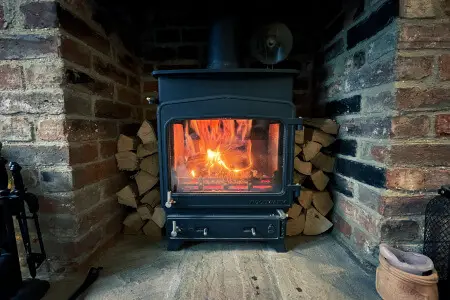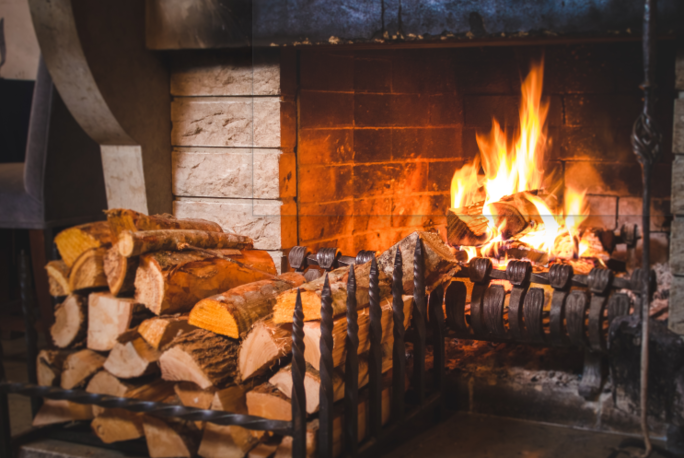Your wood stove may be burning too fast due to excessive airflow into the chamber, causing the fire to extinguish quickly. To remedy this, consider restricting the air by partially closing the vents while maintaining a steady burn for a longer-lasting fire.
When attempting to manage a wood stove, it is essential to understand the factors that can affect its burning rate. By regulating the airflow and ensuring proper wood loading techniques, you can optimize the burning process. Overlooking these aspects can lead to inefficient combustion and an accelerated burn rate.
In this guide, we will explore practical tips and strategies to help you enhance the efficiency of your wood stove and achieve a more sustained burn for extended warmth and comfort.


Credit: www.homefire.co.uk
Understanding Wood Stove Efficiency
Wood stove efficiency plays a vital role in how quickly your wood stove burns. By understanding the factors that contribute to fast wood stove burning, you can improve the efficiency of your stove and prolong burn times.
Causes Of Fast Wood Stove Burning
- Door seals on stoves need replacement due to wear.
- Leaving vents fully open for extended periods causes rapid burning.
Impact Of Airflow On Wood Stove Efficiency
Proper airflow control is crucial for maintaining wood stove efficiency:
- Use only well-seasoned hardwood for optimal burn duration.
- Fully load the firebox to maximize heat output.
- Set air damper to a ‘low airflow’ setting to slow down combustion.
To make a wood stove burn longer and more efficiently, it’s essential to follow these best practices. By optimizing airflow and being mindful of the wood you use, you can enjoy extended burn times and a cozy, warm atmosphere in your home.
Tips For Slowing Down Wood Stove Flames
To slow down wood stove flames and prevent fast burning, restrict the airflow into the chamber by partially closing the vents after adding logs. This method allows the fire to burn slower and last longer, providing extended warmth and efficiency for your wood stove.
Additionally, using well-seasoned hardwood and fully loading the firebox can also help maintain a longer, steady burn.
Choosing The Right Wood
- Opt for well-seasoned hardwood to burn slower and more efficiently.
- Avoid softwoods or green wood that burn faster and produce less heat.
- Ensure the wood is cut to the appropriate size for your stove.
Optimizing Firebox Loading
- Fill the firebox completely with wood to maintain a consistent burn.
- Arrange logs carefully to allow for proper airflow within the stove.
- Avoid overloading the firebox, which can lead to a fast burn rate.
Controlling Airflow
- Adjust the air vents to regulate the flow of oxygen into the stove.
- Start by closing the vents slightly to slow down the burn rate.
- Monitor the airflow and make adjustments as needed to maintain a steady flame.
Maintaining A Long-lasting Fire
If you’ve noticed that your wood stove burns through fuel quickly, leaving you with a short-lived fire, there are several key factors you should consider to maintain a long-lasting, steady flame. From proper maintenance of door seals to selecting the right type of wood, here are essential tips for achieving a slow, enduring burn in your wood stove.
Proper Maintenance Of Door Seals
To maintain a long-lasting fire, it’s crucial to ensure that the door seals on your wood stove are in optimal condition. Over time, door seals may deteriorate, leading to air leaks that can result in a faster burn rate. Regularly inspect the door seals for wear and tear, and replace them as needed to create a tight seal that helps control the airflow and prolong the burning process.
Utilizing Hardwood For Slow Burns
Choosing the right type of wood can significantly impact the burn time of your wood stove. Selecting dense hardwood, such as oak, maple, or birch, can result in a slower and more enduring burn compared to softer woods like pine or spruce. Hardwoods have a higher energy density and release heat more slowly, allowing for a longer-lasting fire and reduced frequency of refueling.

Credit: www.npr.org
Common Mistakes To Avoid
To prevent your wood stove from burning too quickly, ensure proper airflow by adjusting the vents after adding logs. Use hardwood, fully load the firebox, set the air damper to low airflow, and enjoy longer, warmer fires. Avoid leaving vents fully open for extended periods to control the burn rate effectively.
Common Mistakes to AvoidOveruse Of Softwood
One common mistake that can lead to fast-burning wood stove fires is the overuse of softwood. Softwood, such as pine or spruce, may be more readily available and cheaper than hardwood, but it burns at a much faster rate. The high resin content in softwood causes it to ignite quickly, resulting in a shorter burn time.
If you want to slow down your wood stove burn and enjoy longer-lasting fires, opt for hardwood instead. Hardwood, such as oak or maple, burns more slowly due to its density and lower resin content. It provides a steady heat source and ensures that your wood stove maintains a consistent temperature for a longer period of time.
By using hardwood instead of softwood, you can maximize the efficiency of your wood stove and get more heat output for longer durations.
Air Leaks And Oxygen Supply
Another mistake that can cause your wood stove to burn fast is the presence of air leaks, which can disrupt the oxygen supply in the chamber. Air leaks can occur around the door seals, chimney connections, or even through cracks or gaps in the stove itself.
If there are air leaks in your wood stove, it can result in a loss of heat and an increased burn rate. The additional air entering the stove can cause the wood to burn more rapidly, leading to shorter burn times.
To prevent air leaks, regularly inspect and maintain the door seals, gaskets, and chimney connections. Replace any damaged or worn-out seals to ensure a proper seal. Additionally, inspect the stove for any cracks or gaps and seal them with high-temperature silicone or stove cement.
By eliminating air leaks and ensuring a steady supply of oxygen, you can control the burn rate of your wood stove and enjoy longer burn times.
In conclusion, avoiding common mistakes can help you slow down the burn rate of your wood stove and extend the duration of your fires. Opt for hardwood instead of softwood to maximize burn time, and regularly check for and seal any air leaks to maintain a steady oxygen supply. By following these tips, you can get the most out of your wood stove and enjoy cozy fires that last longer.Conclusion And Final Tips
To prevent your wood stove from burning too fast, adjust the airflow by gradually closing the vents after adding logs. Opt for hardwood, fully load the firebox, and set the air damper to a low airflow setting for a longer, sustained burn.
Enjoy hours of warmth and relaxation with these tips for an extended wood stove burn.
E Nsuring Correct Draft Control
If you are wondering why your wood stove burns so fast and fuel seems to disappear quickly, it is crucial to ensure correct draft control. Draft control plays a significant role in regulating the amount of air flowing into your stove, which determines the combustion rate and the speed at which your fire burns.
To achieve correct draft control, follow these tips:
- Inspect the seals and gaskets on your stove’s door to ensure they are intact and not worn out. If there are any leaks, replace the seals to prevent excessive air intake, which can lead to faster burning.
- When loading the wood into the firebox, avoid overcrowding the stove. It is essential to leave enough space for proper airflow and combustion.
- Adjust the air vents or dampers according to the manufacturer’s instructions. By gradually closing the vents once the fire is lit, you can restrict the air supply and slow down the burning process.
M Onitoring Fire For Ideal Burning
To maintain a long-lasting and efficient fire in your wood stove, it is essential to monitor it closely and make necessary adjustments. Here are some tips on how to achieve ideal burning:
- Use only well-seasoned hardwood as fuel for your wood stove. Seasoned wood burns more efficiently and produces higher heat output, allowing your fire to burn longer.
- Make sure to fully load the firebox with wood. A well-packed firebox ensures consistent and continuous burning without the need for frequent reloading.
- Set the air damper or airflow control to the “low airflow” setting. This helps regulate the oxygen supply, preventing rapid burning and extending the burn time.
- Regularly check and clean the flue or chimney to ensure proper ventilation. A clean chimney allows for better draft control and improves the overall performance of your wood stove.
Remember, by taking the necessary steps to ensure correct draft control and monitoring your fire for ideal burning, you can address the issue of your wood stove burning too fast. Implement these tips to enjoy longer burn times and maximize the efficiency of your wood stove.

Credit: mffire.com
Frequently Asked Questions For Why Does My Wood Stove Burn So Fast
How Do I Make My Wood Stove Burn Slower?
To make your wood stove burn slower, restrict the airflow by partially closing the vents once logs are added. Using well-seasoned hardwood, fully loading the firebox, and setting the air damper to low airflow can also help maintain a longer, warmer fire.
Avoid softwood and ensure proper sealing for efficient burning.
Why Is My Wood Burning Stove Burning Too Fast?
If your wood burning stove is burning too fast, try to restrict the airflow into the chamber by partially closing the vents after adding logs. This will help the fire burn slower and last longer. Additionally, check if the door seals need to be replaced and avoid leaving the vents fully open for extended periods of time.
How Do You Keep A Fire Burning Longer In A Wood Stove?
To keep a fire burning longer in a wood stove, follow these steps: 1. Use well-seasoned hardwood. 2. Fully load the firebox. 3. Set the air damper to ‘low airflow’ setting. 4. Avoid opening the vents fully for long periods of time.
5. Sit back, relax, and enjoy hours of warmth! By adhering to these practices, your fire will burn slower and last longer.
How Do You Stop Wood From Burning So Fast?
To stop wood from burning so fast, restrict the air flow into your fire. Also, use well-seasoned hardwood and stack the fire correctly. By closing the vents partially after adding logs, you can slow down the burn and prolong the fire.
Why Is My Wood Burning Stove Burning Too Fast?
The fire burns too fast due to worn door seals or leaving the vents fully open for long periods of time.
Conclusion
The speed at which your wood stove burns can be influenced by various factors, such as air flow and the type of wood used. By ensuring proper ventilation and using well-seasoned hardwood, you can help maintain a longer, more efficient burn.
Following these best practices can help you enjoy a cozy fire for longer periods.
